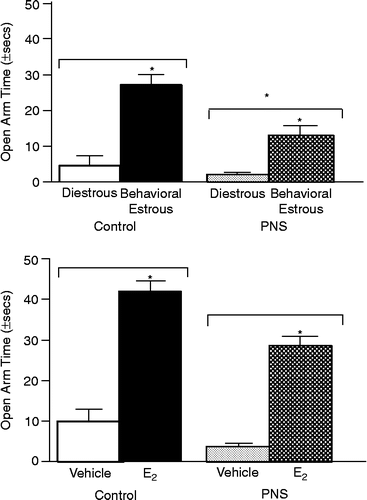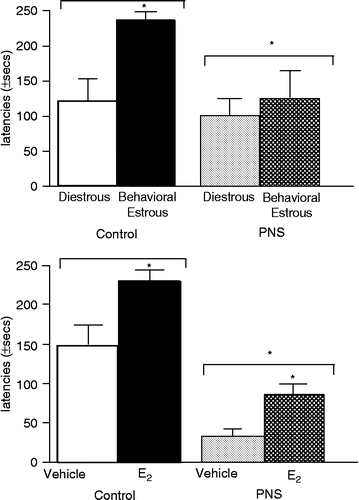Figures & data
Table I. Plasma concentrations (pg/ml; mean±SEM) of estradiol in rats that were gestationally-stressed or not, and intact at different stages of the estrous cycle, or OVX and administered estradiol or vehicle via subcutaneous silastic capsules.
Table II. Plasma concentrations (μg/dl; mean±SEM) of corticosterone in rats that were gestationally-stressed or not, and intact at different stages of the estrous cycle or OVX and administered estradiol or vehicle via subcutaneous silastic capsules.
Table III. Total entries made in the open field (mean±SEM) in rats that were gestationally-stressed or not, and intact in different stages of the estrous cycle or OVX and administered estradiol or vehicle via subcutaneous silastic capsules.
Figure 1 The mean ( ± SEM) number of entries made into the center squares of the open field by gestationally-stressed (PNS) and non-stressed control rats that were in diestrous or behavioral estrous (top) or OVX and administered vehicle or estradiol (E2; bottom). *Above bar indicates significant increases compared to diestrous (top) or vehicle-administration (bottom; P < 0.05).

Figure 2 The mean ( ± SEM) time (seconds) spent in the open arms of the elevated plus maze by gestationally-stressed (PNS) and non-stressed control rats that were in diestrus or behavioral estrus (top) or OVX and administered vehicle or estradiol (E2; bottom). *Above bar indicates significant increases compared to diestrous (top) or vehicle-administration (bottom; P < 0.05). *Above grouped bars indicates difference from control rats (P < 0.05).

Figure 3 The mean ( ± SEM) latency (seconds) to enter the dark, shock-associated side of the inhibitory avoidance chamber of gestationally-stressed (PNS) and non-stressed control rats that were in diestrus or behavioral estrus (top) or OVX and administered vehicle or estradiol (E2; bottom). *Above bar indicates significant increases compared to diestrous (top) or vehicle-administration (bottom; P < 0.05). *Above grouped bars indicates significant difference from control rats (P < 0.05).
